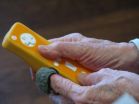(Press-News.org) MARCH 5, 2013—Baltimore, MD—The Center for Biosecurity of UPMC today released online ahead of print a new report, When Good Food Goes Bad: Strengthening the US Response to Foodborne Disease Outbreaks. The authors analyzed existing data and studies on foodborne illness outbreak response, identified emerging trends, and interviewed dozens of federal and state-level officials and experts from industry, professional organizations, academia, and relevant international organizations. The report puts forth a series of recommendations to accelerate and strengthen responses to foodborne illness outbreaks in the US.
Last year, the US was hit with one of the deadliest foodborne illness outbreaks in recent memory when contaminated cantaloupe sickened more than a hundred people and killed dozens. The contamination was eventually traced to fruit from a single processing plant, but in addition to the illness and death that resulted, the entire cantaloupe industry was affected when the price of cantaloupes dropped by more than 30% nationwide as consumer fear drove down demand.
Each year more than 40 million Americans become sick with foodborne infections. Among those who become ill, 128,000 will be hospitalized and 3,000 will die. Foodborne illness also takes a toll on our economy: Every year the US loses more than $77 billion in lost productivity by people who become sick, in addition to the economic impact a foodborne illness outbreak has on the affected industry.
Much effort has gone into preventing foodborne illness outbreaks. In 2010, the Food Safety Management Act was passed, and, although it has not yet been fully funded or implemented, it focuses federal efforts on preventing contamination of food supply.
But even with more and better prevention efforts, it is economically, politically, and scientifically difficult to guarantee 100% protection of the US food supply. Thus, the authors of this report argue, we need to increase our focus on improving the speed and accuracy with which we detect and respond to outbreaks.
"The sooner the source of an outbreak is identified, the sooner we can issue accurate targeted warnings and take the contaminated products off the shelves," notes Jennifer Nuzzo, author of the report. "And the sooner people stop eating contaminated food, the sooner the sickness stops."
Once protective actions are implemented, additional illness and death, as well as economic tolls, can be minimized. The report recommends several actions, including:
Bolster the public health departments that conduct outbreak investigations so that they have the tools and people they need to detect outbreaks, quickly identify the source, and issue targeted warnings. When public health departments are able to quickly solve outbreaks, it saves lives.
Tap the expertise of the private sector to help us solve outbreaks. The US food supply is becoming increasingly complex, and as a result outbreaks are becoming more difficult to solve. We need to find ways of soliciting expertise from the people who know how production and distribution systems are organized and use that to inform public health investigations of outbreaks.
Develop technologies to ensure that our national foodborne illness surveillance programs stay up to date and relevant.
###
The report, When Good Food Goes Bad: Strengthening the US Response to Foodborne Disease Outbreaks, appears on the Center's website at http://www.upmc-biosecurity.org/.
The Center for Biosecurity is an independent, nonprofit organization of UPMC whose mission is to strengthen US national security and resilience by reducing dangers posed by epidemics, biothreats, nuclear disasters, and other destabilizing events. END
When good food goes bad
New report focuses on strengthening US response to illness outbreaks
2013-03-05
ELSE PRESS RELEASES FROM THIS DATE:
Nurse migration in North and Central America strengthening health systems
2013-03-05
International nurse migration is a multibillion-dollar global phenomenon. Historically, Mexicans and Central Americans have not played a significant part in the migration of nurses to the United States. A new report, Strengthening health systems in North and Central America: What role for migration?, sponsored by the Migration Policy Institute (MPI), seeks to draw attention to the cross-border migration in the Americas and suggests ways the migration could be managed to meet the demand for health care services in the region.
The report, co-authored by New York University ...
Gravitational lens creates cartoon of space invader
2013-03-05
The gravitational field surrounding this massive cluster of galaxies, Abell 68, acts as a natural lens in space to brighten and magnify the light coming from very distant background galaxies.
Like a fun house mirror, lensing creates a fantasy landscape of arc-like images and mirror images of background galaxies. The foreground cluster is 2 billion light-years away, and the lensed images come from galaxies far behind it.
In this photo, the image of a spiral galaxy at upper left has been stretched and mirrored into a shape similar to that of a simulated alien from the ...
EARTH: Releasing a flood of controversy on the Colorado River
2013-03-05
Alexandria, VA – As the Colorado River winds through the Colorado Plateau's soft sedimentary strata, it picks up a tremendous amount of sediment. This sediment – which once left the river's waters so muddy that Spanish explorers christened it El Rio Colorado "the reddish river" – is a vital component to the unique ecosystems of the river. However, with the construction of the Hoover and Glen Canyon dams, which trap the sediment, the once-turbid waters have become a dazzling blue-green, signaling major changes with serious implications for the health of the river's native ...
Is the iPad creative? It depends on who's buying it
2013-03-05
Encouraging consumers to feel ownership of products they haven't yet purchased can backfire because consumers tend to see themselves in the products they own, according to a new study in the Journal of Consumer Research.
"Companies assume that consumers who are made to feel ownership of a product prior to purchase will prefer it over competing products, but this can actually have the opposite effect and lead consumers to judge the product less favorably," write authors Liad Weiss and Gita V. Johar (both Columbia University).
Companies encourage us to feel a sense of ...
Product promotion: When do emotional appeals trump celebrity spokespeople?
2013-03-05
Emotional appeals could be more effective than celebrities when promoting products related to a consumer's identity, according to a new study in the Journal of Consumer Research.
"Specific emotions can help consumers strengthen their identities by providing information about how to feel a particular identity, especially when emotions are associated with distinct patterns of action. Consumers tend to choose products that bolster emotions associated with a particular identity," write authors Nicole Verrochi Coleman (University of Pittsburgh) and Patti Williams (Wharton ...
Novel small molecules used to visualize prostate cancer
2013-03-05
Two novel radiolabeled small molecules targeting prostate-specific membrane antigen (PSMA) have excellent potential for further development as diagnostic and therapeutic radiopharmaceuticals, according to research published this month in The Journal of Nuclear Medicine. The imaging agents—123I-MIP-1072 and 123I-MIP-1095—were shown to have a high sensitivity of lesion detection in bone, soft tissue and the prostate gland with minimal retention in non-target tissue.
An estimated 238,500 men will be diagnosed with prostate cancer in 2013, and 29,700 will die from the disease. ...
Are new national policies designed to reduce hospital readmissions working?
2013-03-05
New Rochelle, NY, March 5, 2013–Reducing preventable hospital readmissions is a cornerstone of emerging healthcare policy. The U.S. government has developed payment policies that will decrease payments to hospitals with excess patient readmission levels, for example. Early lessons learned from these current policy initiatives hint at their likelihood for success and are examined in an insightful article in Population Health Management, a peer-reviewed journal from Mary Ann Liebert, Inc., publishers. The article is available free on the Population Health Management website ...
EEG patterns indicate when patients lose, regain consciousness under propofol anesthesia
2013-03-05
Massachusetts General Hospital (MGH) investigators have identified specific EEG (electroencephalogram) signatures that indicate when patients lose and regain consciousness under the general anesthetic drug propofol. Their report being published online in PNAS Early Edition is part of a major MGH-based investigation into the mechanisms behind general anesthesia and builds on the results of a November 2012 paper.
"We have discovered highly structured EEG patterns that indicate when people are sedated during administration of propofol, when they are unconscious and when ...
Seniors who play video games report better sense of emotional well-being
2013-03-05
New research from North Carolina State University finds that older adults who play video games report higher levels of emotional well-being.
Researchers asked 140 people aged 63 and older how often they played video games, if at all. The study participants then took a battery of tests to assess their emotional and social well-being. 61 percent of study participants played video games at least occasionally, with 35 percent of participants saying they played at least once per week.
The study found that participants who played video games, including those who only played ...
Before and after: Ad placement should reflect cultural conceptions of time
2013-03-05
Consumers respond more favorably to advertising when the placement of product images is consistent with the way they visualize time, according to a new study in the Journal of Consumer Research.
"Whether a product's image is placed on the left or the right of an advertisement matters for products promising results occurring over time (weight loss aids or anti-aging creams) or products that are valued because they are old or new (antique furniture, modern art, wine, new technologies)," write authors Boyoun (Grace) Chae and JoAndrea Hoegg (both University of British Columbia).
Consumers ...
LAST 30 PRESS RELEASES:
Making lighter work of calculating fluid and heat flow
Normalizing blood sugar can halve heart attack risk
Lowering blood sugar cuts heart attack risk in people with prediabetes
Study links genetic variants to risk of blinding eye disease in premature infants
Non-opioid ‘pain sponge’ therapy halts cartilage degeneration and relieves chronic pain
AI can pick up cultural values by mimicking how kids learn
China’s ecological redlines offer fast track to 30 x 30 global conservation goal
Invisible indoor threats: emerging household contaminants and their growing risks to human health
Adding antibody treatment to chemo boosts outcomes for children with rare cancer
Germline pathogenic variants among women without a history of breast cancer
Tanning beds triple melanoma risk, potentially causing broad DNA damage
Unique bond identified as key to viral infection speed
Indoor tanning makes youthful skin much older on a genetic level
Mouse model sheds new light on the causes and potential solutions to human GI problems linked to muscular dystrophy
The Journal of Nuclear Medicine ahead-of-print tip sheet: December 12, 2025
Smarter tools for peering into the microscopic world
Applications open for funding to conduct research in the Kinsey Institute archives
Global measure underestimates the severity of food insecurity
Child survivors of critical illness are missing out on timely follow up care
Risk-based vs annual breast cancer screening / the WISDOM randomized clinical trial
University of Toronto launches Electric Vehicle Innovation Ontario to accelerate advanced EV technologies and build Canada’s innovation advantage
Early relapse predicts poor outcomes in aggressive blood cancer
American College of Lifestyle Medicine applauds two CMS models aligned with lifestyle medicine practice and reimbursement
Clinical trial finds cannabis use not a barrier to quitting nicotine vaping
Supplemental nutrition assistance program policies and food insecurity
Switching immune cells to “night mode” could limit damage after a heart attack, study suggests
URI-based Global RIghts Project report spotlights continued troubling trends in worldwide inhumane treatment
Neutrophils are less aggressive at night, explaining why nighttime heart attacks cause less damage than daytime events
Menopausal hormone therapy may not pose breast cancer risk for women with BRCA mutations
Mobile health tool may improve quality of life for adolescent and young adult breast cancer survivors
[Press-News.org] When good food goes badNew report focuses on strengthening US response to illness outbreaks


